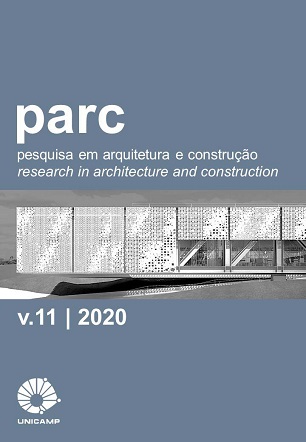Abstract
The Brazilian standard NBR 15.575 states that thermal performance evaluation of a building should be conducted by the relationship between outdoor temperature and indoor temperature conditions for summer and winter design days, which allows quantifying the compliance of the user requirements. Thus, this research aims to evaluate the thermal performance of a building considering different methods to determine the summer and winter days and different algorithms to calculate solar radiation (sky model). The methodology starts from a building located in bioclimatic zone 7, for which three sky model algorithms were tested, through computer simulation, for summer and winter design days. Without considering the sky clearness, the maximum and minimum indoor temperatures suffered slight variations when using different methods to obtain the design days, resulting in a Superior thermal performance level for the researched building. When considering the sky models, introducing sky clearness as an input parameter on the summer design day, the performance level was also Superior for the ASHRAEClearSky and ASHRAETau models, and intermediate for the Zhang Huang model, showing that the sky models can influence the performance classification. The ASHRAETau model provided, for the summer design day, underestimated indoor temperatures compared to other sky models, so its use is not recommended. Similar behavior was obtained for winter design day. The study subsidizes the construction of the design day for Brazilian cities not specified in the Brazilian standard, contributing to analyzing the existent gaps on normative parameters.
References
ABNT - ASSOCIAÇÃO BRASILEIRA DE NORMAS TÉCNICAS. NBR 15220: Desempenho térmico de edificações. Rio de Janeiro, 2005.
ABNT - ASSOCIAÇÃO BRASILEIRA DE NORMAS TÉCNICAS. NBR 15575-1: Edifícios habitacionais – Desempenho. Rio de Janeiro, 2013.
AKUTSU, M. Método para avaliação do desempenho térmico de edificações no Brasil. 1998, 156 f, Tese (Doutorado em Arquitetura) – Faculdade de Arquitetura e Urbanismo, Universidade de São Paulo, São Paulo, 1998.
AKUTSU, M., VITTORINO, F. Tratamento de dados climáticos para a avaliação do desempenho térmico de edificações Manual de Procedimentos (Aplicação à Cidade de São Paulo) - Anexo I. São Paulo, 1998. Publ. IPT 1732, 1998.
ASHRAE - AMERICAN SOCIETY OF HEATING, REFRIGERATING AND AIR-CONDITIONING ENGINEERS. Handbook – Fundamentals. Atlanta: ASHRAE, 2009.
BANCO DE DADOS METEOROLÓGICOS. Dados Históricos Anuais. In: INSTITUTO NACIONAL DE METEOROLOGIA. INMET Dados Meteorológicos. Brasília, DF: INMET, [1999 a 2009]. Disponível em: http://www.inmet.gov.br/portal/. Acesso em: 9 mai. 2019.
BRITO, A. C; AKUTSU, M; VITTORINO, F.; AQUILINO, M. M. Contribuições Para o Aprimoramento da NBR 15575 Referente ao Método Simplificado de Avaliação de Desempenho Térmico de Edifícios. In: ENCONTRO NACIONAL DE TECNOLOGIA DO AMBIENTE CONSTRUÍDO, 14. Juiz de Fora, 2012. Anais [...]. Juiz de Fora: ENTAC, 2012.
ENERGYPLUS DOCUMENTATION. Engineering Reference. U.S Department of Energy, v. 8.8.0, California, 2017.
FERREIRA, C. C.; PEREIRA, I. M. Avaliação do desempenho térmico de habitação de interesse social de acordo com a NBR 15575, para as diversas zonas bioclimáticas. In: ENCONTRO NACIONAL DE TECNOLOGIA DO AMBIENTE CONSTRUÍDO, 14., Juiz de Fora, 2012. Anais [...]. Minas Gerais: ANTAC, 2012.
GONÇALVES, O. M. et al. Normas técnicas para avaliação de sistemas construtivos inovadores para habitações. In: ROMAN, H.; BONIN, L. C. (ed.) Coletânea Habitare: Normalização e certificação na construção habitacional – Vol. 3. Porto Alegre: ANTAC, 2003.
KUBO, G. K. A influência das variáveis do Design Day, consideradas na simulação com o EnergyPlus desconsideradas pela NBR 15.575/2013, nos resultados de desempenho térmico de edificações. 2017. Dissertação (Mestrado) - Escola Politécnica da Universidade de São Paulo. São Paulo, 2017.
OMETTO, J. C. Bioclimatologia vegetal. São Paulo: Ceres, 1981. 440p.
SCHELLER, C; SORGATO, M. J; MELO, A. P; LAMBERTS, R. Análise de Arquivos Climáticos para a Simulação do Desempenho Energético de Edificações. Florianópolis: Centro Brasileiro de Eficiência em Edificações, 2015.
SIQUEIRA, T. C. P. A.; AKUTSU, M.; LOPES, J. I. E.; SOUZA, H. Ar. de. Dados climáticos para avaliação de desempenho térmico de edificações. Rem: Rev. Esc. Minas. v.58, n.2, p.133-138, 2005. DOI: http://dx.doi.org/10.1590/S0370-44672005000200007
SOARES, M. M.; SILVA, A. C. S. B. da. Análise e compatibilização dos métodos simplificado e por simulação da NBR 15575: zona bioclimática 2. Ambiente Construído, Porto Alegre, v. 17, n. 1, p. 305-327, jan./mar. 2017. DOI: http://dx.doi.org/10.1590/s1678-86212017000100137
SORGATO, M. J.; MELO, A. P.; LAMBERTS, R. Análise do Método de Simulação de Desempenho Térmico da Norma NBR 15575. In: ENCONTRO NACIONAL DE CONFORTO NO AMBIENTE CONSTRUÍDO, 12. Brasília, 2013. Anais [...]. Brasília: ANTAC, 2013.
SORGATO, M. J.; MELO, A. P.; LAMBERTS, R. Análise do método de simulação de desempenho térmico da norma NBR 15.575. Paranoá: cadernos de arquitetura e urbanismo, v. 12, n. 12, 29 set. 2014. DOI: https://doi.org/10.18830/issn.1679-0944.n12.2014.12205
TERAMOTO, É. T.; ESCOBEDO, J. F. Análise da frequência anual das condições de céu em Botucatu, São Paulo. Revista Brasileira de Engenharia Agrícola e Ambiental, v.16, n.9, p.985–992, 2012. http://dx.doi.org/10.1590/S1415-43662012000900009
WEATHER COMPANY. Weather Underground: Weather Forecast & Reports. Disponível em: https://www.wunderground.com/. Acesso em: out, 2017.
WATANABE, T., URANO, Y.; HAYASHI, T. Procedures for Separating Direct and Diffuse Insolation on a Horizontal Surface and Prediction of Insolation on Tilted Surfaces (in Japanese). Transactions of the Architectural Institute of Japan. v. 330, p. 96-108, 1983. DOI: https://doi.org/10.3130/aijsaxx.330.0_96
ZHANG, Q. Y; HUANG, Y. J. Development of typical year weather files for Chinese locations. ASHRAE Transactions, v. 108, n. 2, 2002.
I accept that PARC Research in Architecture and Building Construction journal perform, on the original file approved for publication, revisions and modifications in orthoghaphic, grammar and standard issues.
I give to PARC Research in Architecture and Building Construction journal the rights of first publication of the revised version of my paper, licensed under the 'Creative Commons Attribution' license (which allows sharing the work with the recognition of first authorship and publication in this journal).


